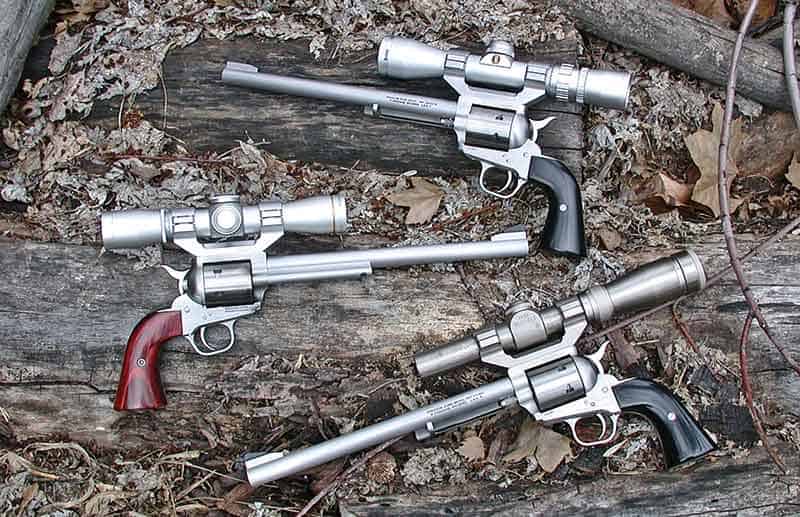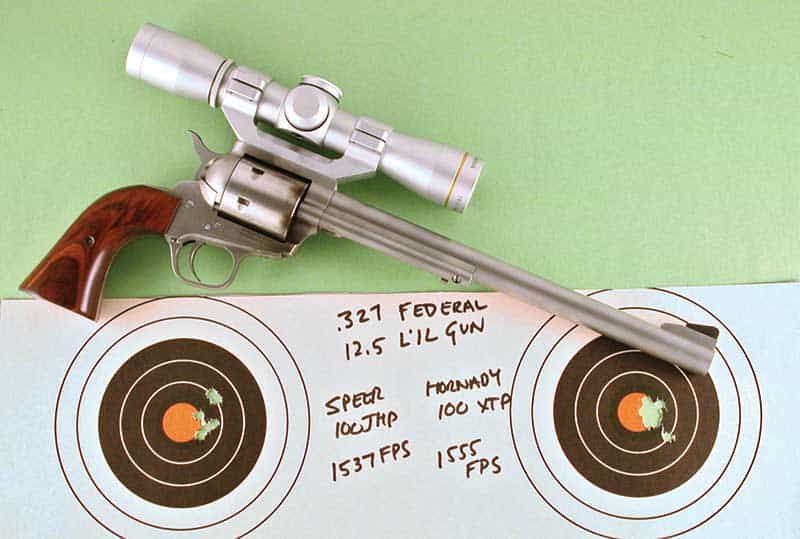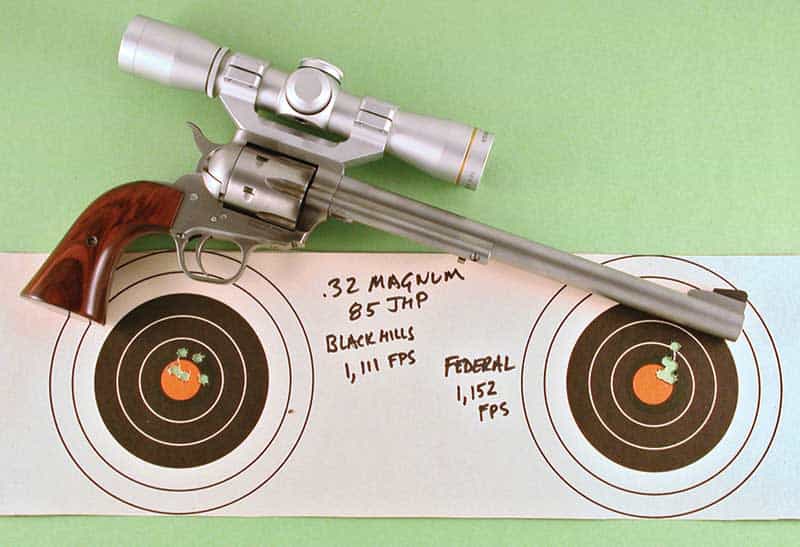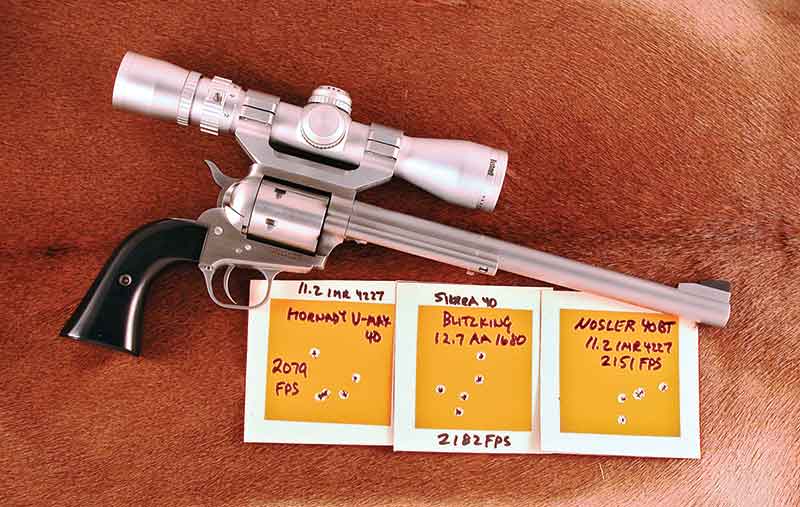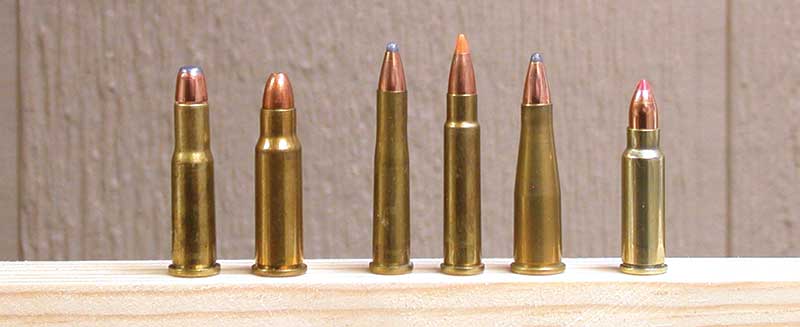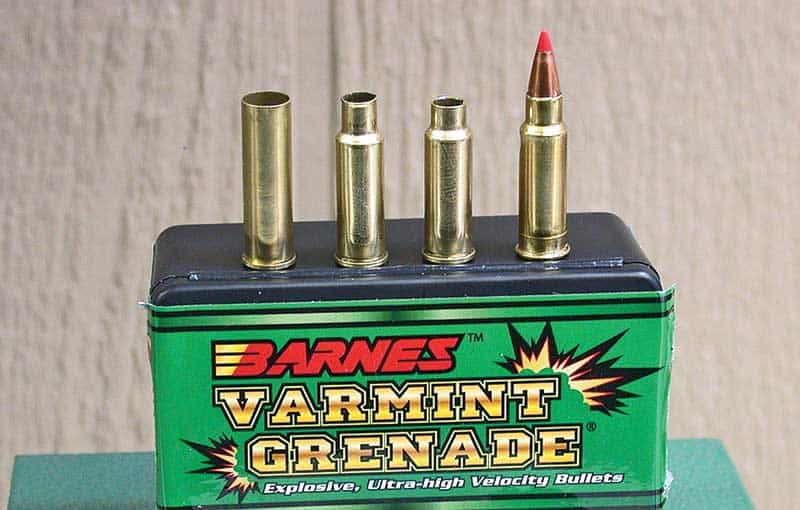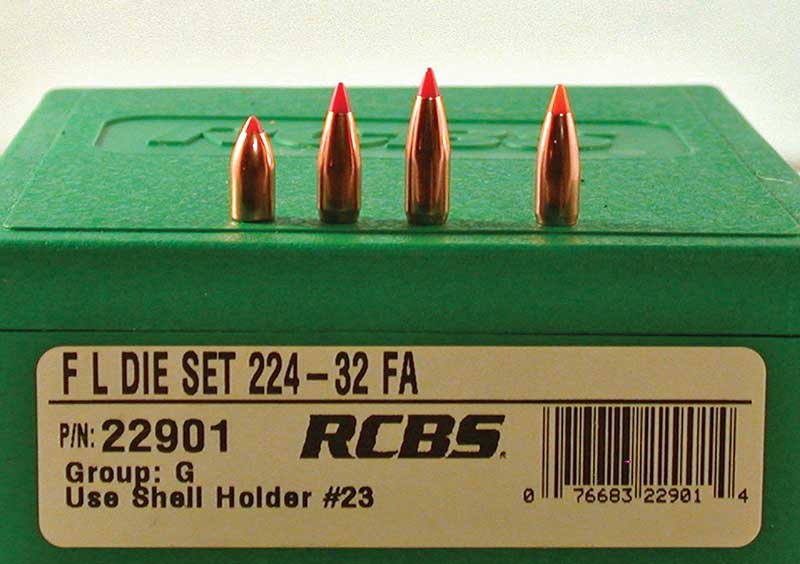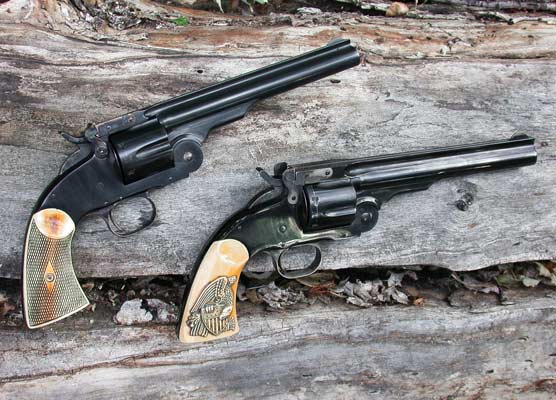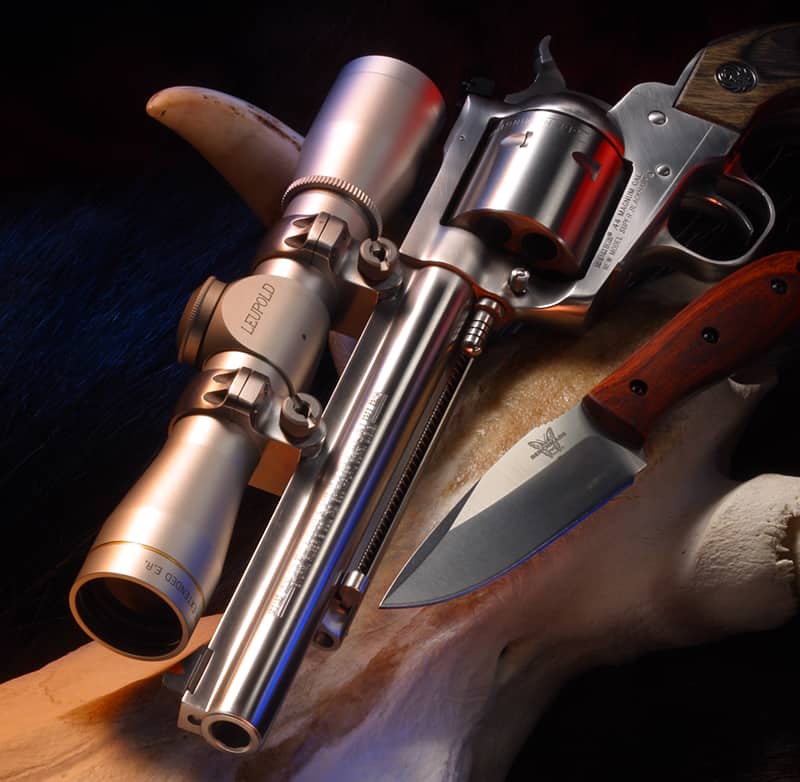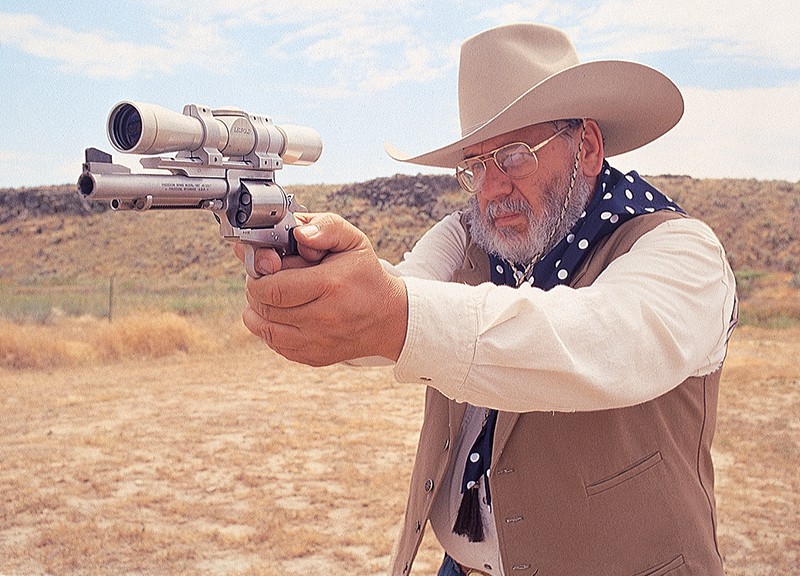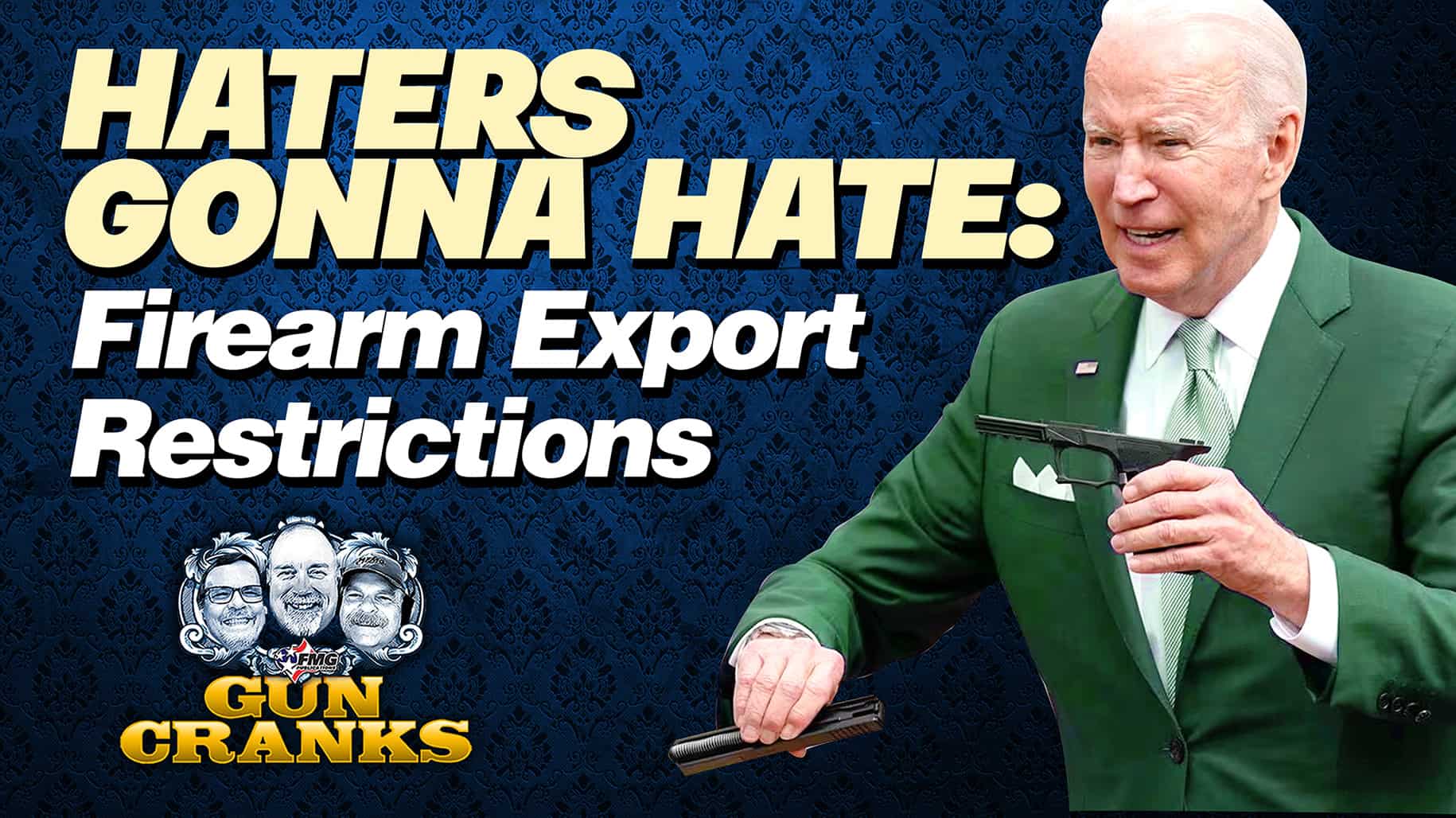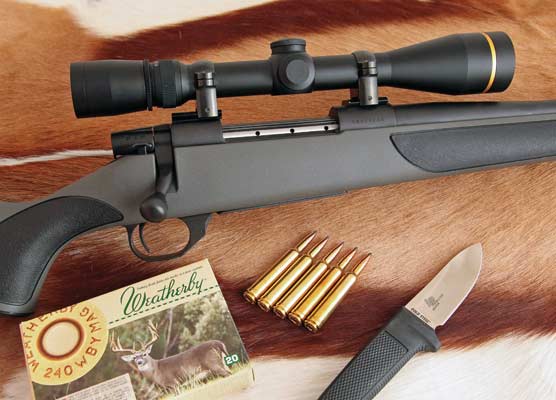These Are The New
"New Varminters"
The Smallbore Freedom
Arms Model 97 Revolvers
When the .17 HMR arrived, Freedom Arms gave dedicated varmint hunters this cartridge chambered in the Model 97. Freedom Arms unveiled two more versions of the Model 97, both on the pleasant shooting, small game and varmint side. The introduction of the Model 97 in .32 Magnum, especially with a 7-1/2″ barrel gave shooters the epitome of .32 Magnum sixguns and the addition of a .32-20 cylinder made it even more versatile.
When Federal introduced the .327 Magnum they succeeded in making the .32 H&R Magnum what it should have been in the first place. Originally, and still for most manufacturers of revolvers, the .327 is mainly looked upon as a self-defense cartridge chambered in the short-barreled pocket pistols. However, the .327 which is simply a longer .32 Magnum, is worthy of other homes. Freedom Arms is the first to offer it in a long-barreled hunting version.
“By the time you come up
with successful loads for the .224,
you will have experienced a graduate
course in case forming, and
if I can do it, anyone can.”
To arrive at the Freedom Arms .327, they simply added another cylinder to the .32 Magnum Model 97, and I am now shooting a 10″ scope-sighted .327 Federal/.32 Magnum/.32-20. However, Bob Baker of Freedom Arms did not stop there. At the 2008 Shootists’ Holiday we were able to shoot the third cartridge pioneered by Freedom Arms. First came the .454, then the .500 WE and now we have the .224-32 FA. To arrive at this fast-stepping .22, Baker necked down the .327 Federal Magnum.
Freedom Arms offers a full kit consisting of Model 97, RCBS dies, and if desired, a scope mounted in place. Sixgunners can now order the “New Varminters” Trio in identical barrel lengths chambered for the .17 HMR, .327 Federal Magnum and .224-32 FA. The spectrum of varmint hunting is virtually completely covered by these three smallbore sixguns. My original 10″ Model 97 chambered in .17 HMR has now been sided by both the .327 Federal and .224-32 in the same barrel lengths, the only difference in addition to the chambering is my choice of scopes for each one. The .17 wears an old Redfield 2-6X LER scope I acquired nearly 30 years ago, the .327 has been fitted with a new silver Leupold 4X LER scope and I ordered the .224 fitted with Bushnell Variable LER scope by Freedom Arms.
Ammunition for the three New Varminters is quite varied. Being a rimfire cartridge, actually a necked down .22 WMR, the .17 HMR is only available as a factory offering, and factory loads are offered for the .32 Magnum, .32-20, and .327 Federal. Handloaders can improve the first two .32s significantly, as the Freedom Arms Model 97 is able to handle much stouter loads than those offered by the factories.
That brings us to the .224-32 FA which at this point is strictly a do-it-yourself project. Beginning with the .327 Federal case, RCBS dies are used to form the .224-32, which must be trimmed to the proper length, and then fire formed. If you start with once-fired .327 Federal brass, case forming is much easier if it is first re-sized in a carbide sizing die. In fact, if this is not done the cases may collapse when run through the .224-32 sizing die.
Here then are the steps I go through to make a .224-32 FA: 1) Once-fired .327 brass is tumbled clean. 2) It is then sized in a .32 Magnum carbide sizing die. 3) Cases are then hand-lubed with a lanolin-based lube and run through the RCBS .224/32 FA sizing die. 4) Next comes trimming to length using the RCBS Trim Pro power trimmer. 5) Case necks are de-burred inside and out and the cartridge is now ready to be loaded for fire-forming. I have found Step 3 works better if it is separated into two stages, first without the de-capping/expander in place, and then the operation repeated with this stem back in the die.
Cases are then checked to see if they will fit the chambers of the Model 97 properly and if so loaded with 40-grain bullets and fire-formed. I used 12.5 grains of AA1680 for this last step.
Freedom Arms has set the minimum and maximum case lengths at 1.115″ and 1.120″ respectively: mine are trimmed to 1.1185″. The sizing die is set by using a feeler gauge between the bottom of the die and the top of the shell holder; I started at a setting of .005″ and then decreased this to .004″. This allows the shoulder to be pushed back to properly fit the cylinder and also head space correctly for easy cylinder rotation.
Both brass and cylinder chambers must be clean to prevent set-back as was a problem with the .22 Jet (see sidebar). If the lube is not removed from the brass, cases will set back and tie up the cylinder. I use a towel to wipe loaded cartridges clean and also use a spray degreaser on the cylinder chambers followed by cleaning with Q-Tips. I did neither in my first fire-forming loads and I had to remove the cylinder which locked up tightly to extract the cases. When both brass and cylinder are kept clean and dry there is no problem with setback, even with loads faster than 2,200 fps.
Model 97
Maker: Freedom Arms Inc.
314 Hwy 239, Freedom, WY 83120
(307) 883-2468
www.freedomarms.com
Action: Single-action revolver,
Calibers: .17 HMR, .22 LR/.22 WMR, .224-32 FA, .32 Magnum/.327 Federal/.32-20, .357 Mag, .41 Mag, .44 Special, .45 Colt/.45 ACP.,
Capacity: 6 (5 in .41, .44 & .45),
Barrel Length: 4-1/4″, 5-1/2″, 7-1/2″, 10″,
Overall Length: 9.175″ to 15.125″,
Weight: 42 to 51 ounces, Finish: Stainless steel,
Sights: Fixed, adjustable or scope (extra),
Grips: Laminated rosewood,
Price: $1,891 (centerfire), $1,907 (rimfire)
Elite 3200 Handgun Scope
Maker: Bushnell 9200 Cody Ave.,
Overland Park, KS 66214
(800) 423-3537
www.bushnell.com
Magnification: 2X-6X,
Objective Diameter: 1.4″,
Eye Relief: 20″,
Internal Adjustments: 50″ at 100 yards,
Reticle: Multi-X,
Price: $333.99
FX-II Handgun Scope
Maker: Leupold
1440 N.W. Greenbriar Pkwy., Beaverton, OR 97006
(800) 538-7653
www.leupold.com
Magnification: 4X,
Objective Diameter: 1.4″,
Eye Relief: 18″,
Internal Adjustments: 60″ at 100 yards,
Reticles: Duplex,
Price: $349.99
Proper bullets for the .224-32 FA are .224″ in diameter and reloaders have a large selection available from such manufacturers as Barnes, Hornady, Nosler, Sierra and Speer.
Two of the Hornady V-Max bullets as well as the Nosler Ballistic-Tip are of the boattail design which makes loading miniscule bullets in tiny little cases much easier. I have found flat-based bullets can only be used if the necks are given extra expansion with something like a Nexpander tool. If this is not done they will crush the case instead of seating properly. By the time you come up with successful loads for the .224, you will have experienced a graduate course in case forming, and if I can do it, anyone can.
Freedom Arms recommends standard pistol primers and AA1680 and Hodgdon’s 4227 for loading the .224-32. The latter is one of my favorite powders for big-bore sixguns, and AA1680 meters so well through the RCBS powder measure it is pure pleasure. As a test, I set the powder measure for 12.7 grains of 1680 and then threw 10 charges measuring each one. Eight of them came out 12.7, one was 12.6, and the other was 12.8; that is definitely close enough for me. If you start with new-primed .327 Federal brass, Freedom Arm recommends removing the factory Federal 205 primer used for .327 loadings and replacing it with a standard small pistol primer for best results. After my beginning loadings with AA1680 I then switched over to some test loads with 4227 and measuring several charges exhibited the same consistency as with 1680.
Bobby Burns was certainly correct when he talked of the best laid plans of mice and men. I had hoped to shoot the .17 HMR, .224-32 FA and the .327 Federal at 100 yards, or more. I have been waiting nearly 4 months now for the wind to stop blowing to no avail. The shooting range I use is a natural wind tunnel and plays havoc with lightweight bullets.
Usually, good groups can be obtained at 50 yards but after that the wind takes over. Not only does it blow, it blows inconsistently and may come from many directions. It was not unusual in the long-range silhouette in days to see a 150-grain .30-30 bullet blown 3′ sideways at 200 meters. I tried 100-yard groups, but the wind whipped the .17, .22 and .32 bullets all over the target, so for now at least my groups have been confined to 50 yards. I will do a Taffin Tests follow-up piece for our sister publication American Handgunner after the wind stops. Hopefully it will. Someday.
Barnes Bullets
38 N. Frontage Rd., Mona, UT 84645
(800) 574-9200
www.barnesbullets.com
Federal Ammunition
900 Ehlen Dr., Anoka, MN 55303
(800) 322-2342
www.federalpremium.com
Hornady
3625 W. Old Potash Hwy.
Grand Island, NE 68803
(800) 338-3220
www.hornady.com
Nosler
107 S.W. Columbia St., Bend, OR 97702
(800) 285-3701
www.nosler.com
RCBS
605 Oro Dam Blvd., Oroville, CA 95965
(800) 553-5000
www.rcbs.com
Sierra Bullets
1400 W. Henry St., Sedalia, MO 65301
(888) 223-3006
www.sierrabullets.com
Speer Ammo
229 Snake River Ave., Lewiston, ID 83501
(800) 627-3640
www.speer-ammo.com
Handgun Varminting
Long, long ago, in fact three decades before I became a staff writer for this publication, I was a devoted reader going all the way back to the discovery of that first January 1955 issue of GUNS while still in high school. As a young sixgunner I devoured everything I could find to read about guns. Early favorite writers when it came to sixguns were Elmer Keith and Kent Bellah, both of whom wrote for this magazine in the early days.
In the late 1950s, a new writer appeared, with his first articles being published right here. His name was Allen Skelton and one of his first articles was titled “These Are The New Varminters.” I still have that article saved in plastic sheets, and I still enjoy looking at the pictures of his Ruger and Smith & Wesson .357 and .44 Magnums. This young fellow, who so easily caught my imagination and fired my enthusiasm, wrote other articles for GUNS as Charles A. Skelton, and soon went on to greater fame using a nickname from his school days, Skeeter.
In the early 1960s, manufacturers began searching for better cartridges for varmint hunting than the big magnums. From Remington came the .22 Jet, chambered in the S&W Model 53, and the .221 Fireball in the single-shot XP-100. Winchester’s offering was the .256 Winchester, which although chambered in proto-type Colt sixguns, was instead only offered in the single-shot Ruger Hawkeye and Marlin Levermatic. Even before these cartridges arrived, sixgun genius Jim Harvey was using shortened and blown out .22 Hornet brass to form his .224 Harvey Kay-Chuk for use in converted S&W Model 17 revolvers.
The .22 Jet was advertised as obtaining 2,400 fps with a 40-grain bullet. Actual ballistics never even came close to this, more like 1,800 fps and serious problems developed. The .22 Jet was arrived at by necking down the .357 Magnum case to a .22 shaped like a milk bottle.
The major problem with the .22 Jet was set-back. That is, due to its shape, upon firing, the head of the cartridge would jam against the recoil shield thus tying up the sixgun and the cylinder could not be rotated. All manner of things were tried to make the .22 Jet work. I tried them all to no avail, unless powder charges were cut drastically. Now nearly a half-century later what the .22 Jet could not do is possible with the .224-32 FA (Freedom Arms).
Freedom Arms started with the .454 in 1983, “backed down” to the .44 Magnum, and then added such big bores as the .475 Linebaugh and .500 Wyoming Express. These are great cartridges and all and anything that walks can be taken with one or more of them. While producing these magnificent sixguns, Freedom Arms has not forgotten the gentler, kinder crowd. It began with the introduction of the smaller Model 97 chambered in .357 Magnum. This grand cartridge straddles the fence between the truly big bores and the more pleasant-to-shoot smallbores. It is actually a jack-of-all-trades; bigger than necessary for small game and varmints, while in very careful hands with proper loads and bullets can be used for big game.
Freedom Arms then went two directions with the Model 97 after the first one was introduced (and are we thankful for that!). On one hand we have the big-bore .45 Colt, .41 Magnum and .44 Special.
On the other hand we have the very pleasant shooting .22 Long Rifle available with an extra .22 Magnum cylinder and the .32 Magnum with an extra .32-20 cylinder.
I ordered both the .22 Long Rifle and .32 Magnum with 7-1/2″ barrels and their companion auxiliary cylinders when they were first announced. They have proven to be exceptionally accurate sixguns with all four chamberings.

Get More Revolver Content Every Week!
Sign up for the Wheelgun Wednesday newsletter here:

